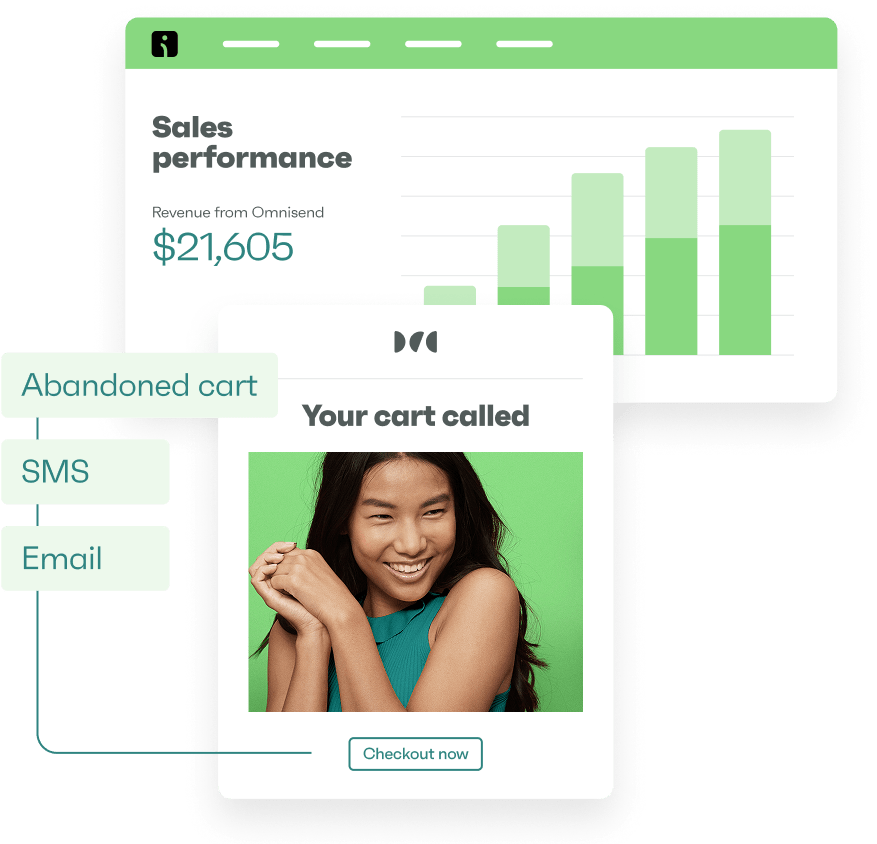Drive sales on autopilot with ecommerce-focused features
See FeaturesBrands have never had as many tools for keeping track of customer behavior and managing operations as they do today. On the one hand, this allows even the smallest businesses to track the performance of their stores and personalize the customer experience. On the other hand, it can cause fragmentation with data being stored across various platforms.
This presents a challenge: making sense of siloed data to get meaningful insights and to deliver the best possible experience for customers.
That’s where the unified customer view comes in.
What is a unified customer view?
A unified customer view (also known as a 360-degree customer view) refers to aggregating customer data from all touchpoints into one customer profile.
This allows merchants to gain deeper insights into their customers, create more targeted marketing campaigns, and improve overall shopping experiences. No more annoying your customers with ads and promotions that have nothing to do with their preferences or past purchases. And at the same time, you’ll have more accessible data with which you can make informed decisions about growing your business.
To create a unified customer view, however, businesses must first find an effective way to connect their data across different platforms. Without a streamlined process for integrating customer information, creating a consistent and convenient customer journey can be a struggle.
The challenges of building a unified customer view
The underlying difficulty with trying to connect data across different platforms is that not all platforms are built with that functionality in mind. As such, some workarounds are needed to get these tools talking to each other.
Here are some common ways companies integrate their platforms:
- APIs (application programming interface): These are a set of rules that let software programs talk to each other. APIs give businesses control over how they connect and manage data, making them great for complex needs, like ensuring data privacy in healthcare or handling lots of transactions.
- Middleware: Tools, like Zapier or Mulesoft, that link apps together so they can share data and automate tasks. These tools are usually easy to use and don’t require technical skills, making them perfect for businesses that want to connect apps quickly, like syncing an online store with a shipping service.
- Webhooks: These tools send real-time updates from one app to another when a certain action is completed, like a new order getting placed. Webhooks are ideal for businesses that need instant updates without constantly checking, but they usually require a bit of coding to set up.
The challenges don’t end there, though. So although many businesses recognize the importance of delivering a unified shopping experience, they can be put off by the challenges of integrating their data.
Here are some of the most common obstacles and how to solve them:
Connecting disparate systems
Whether a start-up or large brand, online retailers must create seamless, personalized shopping experiences to capture customer attention and loyalty. However, using multiple disconnected platforms to manage sales, marketing, and customer relationships can hinder this goal.
A unified ecommerce platform like Shoplazza acts as a one-stop hub, connecting key business functions such as order management, CRM, POS, and marketing automation. This reduces the need for third-party integrations and ensures customers see the same information, such as stock level for an item, whether shopping online or in-store.
Cleaning and structuring data for accuracy
Once systems are connected, the data must be cleaned and organized to make it useful. For example, there may be duplicate customer records that need to be removed, and data formats (e.g., dates, addresses, currencies) need to be consistent.
With a unified platform, customer data is brought together in one place, reducing errors and inconsistencies. Over time, as more data is collected in the single location, merchants can build richer customer profiles. This can lead to better opportunities to understand each customer’s preferences, behaviors, and purchase history, and the ability to deliver a more personalized and smooth customer experience.
Integrating external data into a unified customer view
Not all platforms provide full access to customer data. Social media platforms like Facebook and Instagram or online marketplaces like Amazon limit the information businesses can collect, which makes it difficult to build a completely unified profile.
By strategically integrating external data, businesses can gather valuable insights, even from these limited sources:
- Social media: While platforms don’t share direct customer identifiers (like email or purchase history), businesses can use pixel tracking or first-party cookies to track website visits from users who clicked on social media ads. Offering options like “Sign in with Facebook” or “Sign in with Google” also helps track customers’ social interactions with their shopping behavior.
- Marketplaces (Amazon, eBay, Etsy): These platforms help businesses reach more customers but limit direct access to customer data. By tracking order data from these platforms and comparing it with their own website sales, businesses can still gain valuable insights into customer behavior. This can help improve inventory management, marketing strategies, and customer engagement.
By combining first-party data from a brand’s website with insights from social media and marketplaces, businesses can create more personalized shopping experiences and improve customer relationships.
Creating a unified customer view with Shoplazza and Omnisend
Shoplazza and Omnisend provide the perfect combination to bring together customer data and create highly personalized marketing experiences.
Shoplazza captures customer interactions across both online and offline channels, ensuring that every touchpoint — from ecommerce transactions to in-store purchases through POS systems — is properly tracked and structured. This comprehensive approach helps businesses maintain a complete and accurate customer profile.
Once this data is collected, Omnisend uses the data to drive automated marketing campaigns. By analyzing real-time customer behavior, it can trigger personalized emails and SMS messages at just the right moment. This includes sending abandoned cart reminders to recover lost sales, product recommendation emails based on browsing history, and loyalty or re-engagement campaigns to reward returning shoppers with exclusive offers.
The integration between Shoplazza and Omnisend ensures that data flows seamlessly between platforms, keeping marketing efforts up-to-date with the latest customer interactions. With this powerful connection, businesses can eliminate data silos, enhance personalization, and drive more effective engagement across customer touchpoints.
Final thoughts: Bridging data for a better customer journey
A unified customer view is not just a luxury, it’s a necessity for ecommerce success. By connecting your systems, cleaning your data, and leveraging automation, you can create a seamless, personalized experience that drives customer loyalty and revenue.
The Shoplazza-Omnisend integration simplifies this process, helping you unlock customer insights and execute powerful omnichannel marketing strategies. If you’re ready to take your ecommerce business to the next level, start building your unified customer view today.
Author bio

Matthew Leung is the Digital Marketing Manager at Shoplazza. He has a great passion for data – driven marketing and years of relevant experience. When on vacation, he loves trekking or cycling.
TABLE OF CONTENTS
TABLE OF CONTENTS


No fluff, no spam, no corporate filler. Just a friendly letter, twice a month.

 OFFER
OFFER







